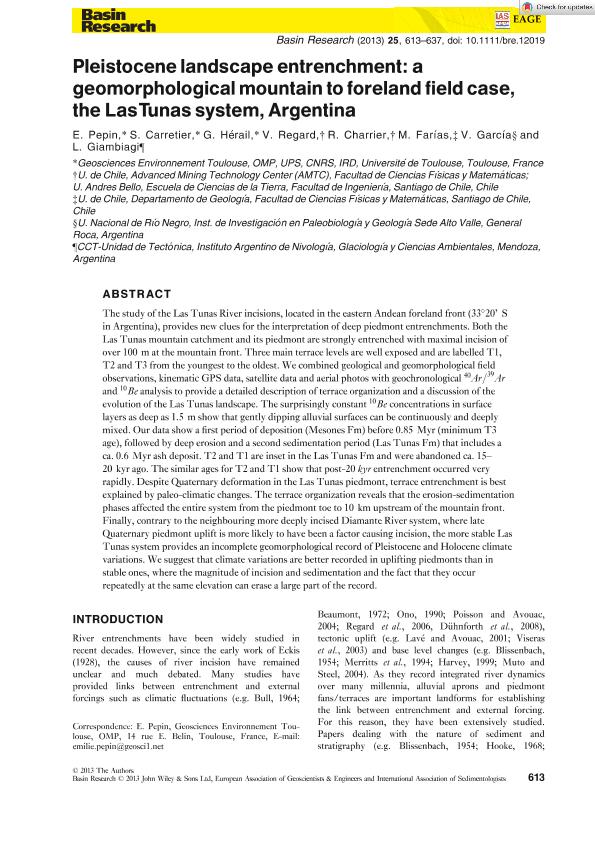Mostrar el registro sencillo del ítem
dc.contributor.author
Pepin, E.
dc.contributor.author
Carrieter, S.
dc.contributor.author
Hérail, G.
dc.contributor.author
Regard, V.
dc.contributor.author
Charrier, R.
dc.contributor.author
Farías, M.
dc.contributor.author
Garcia, Victor Hugo

dc.date.available
2015-12-22T20:47:32Z
dc.date.issued
2013-05-25
dc.identifier.citation
Pepin, E.; Carrieter, S.; Hérail, G.; Regard, V.; Charrier, R. ; et al.; Pleistocene landscape entrenchment: a geomorphological mountain to foreland field case, the Las Tunas system, Argentina; Wiley Blackwell Publishing, Inc; Basin Research; 25; 6; 25-5-2013; 613-637
dc.identifier.issn
0950-091X
dc.identifier.uri
http://hdl.handle.net/11336/3187
dc.description.abstract
The study of the Las Tunas River incisions, located in the eastern Andean foreland front (3320’ S in Argentina), provides new clues for the interpretation of deep piedmont entrenchments. Both the Las Tunas mountain catchment and its piedmont are strongly entrenched with maximal incision of over 100 m at the mountain front. Three main terrace levels are well exposed and are labelled T1, T2 and T3 from the youngest to the oldest. We combined geological and geomorphological field observations, kinematic GPS data, satellite data and aerial photos with geochronological 40 Ar/39 Ar and 10 Be analysis to provide a detailed description of terrace organization and a discussion of the evolution of the Las Tunas landscape. The surprisingly 10 Be constant concentrations in surface layers as deep as 1.5 m show that gently dipping alluvial surfaces can be continuously and deeply mixed. Our data show a first period of deposition (Mesones Fm) before 0.85 Myr (minimum T3 age), followed by deep erosion and a second sedimentation period (Las Tunas Fm) that includes a ca. 0.6 Myr ash deposit. T2 and T1 are inset in the Las Tunas Fm and were abandoned ca. 15–20 kyr ago. The similar ages for T2 and T1 show that post-20kyr entrenchment occurred very rapidly. Despite Quaternary deformation in the Las Tunas piedmont, terrace entrenchment is best explained by paleo-climatic changes. The terrace organization reveals that the erosion-sedimentation phases affected the entire system from the piedmont toe to 10 km upstream of the mountain front. Finally, contrary to the neighbouring more deeply incised Diamante River system, where late Quaternary piedmont uplift is more likely to have been a factor causing incision, the more stable Las Tunas system provides an incomplete geomorphological record of Pleistocene and Holocene climate variations. We suggest that climate variations are better recorded in uplifting piedmonts than in stable ones, where the magnitude of incision and sedimentation and the fact that they occur repeatedly at the same elevation can erase a large part of the record.
dc.format
application/pdf
dc.language.iso
eng
dc.publisher
Wiley Blackwell Publishing, Inc

dc.rights
info:eu-repo/semantics/openAccess
dc.rights.uri
https://creativecommons.org/licenses/by-nc-sa/2.5/ar/
dc.subject
Andes
dc.subject
Mountain -Fan System
dc.subject
Geochronology
dc.subject
Erosion
dc.subject.classification
Geología

dc.subject.classification
Ciencias de la Tierra y relacionadas con el Medio Ambiente

dc.subject.classification
CIENCIAS NATURALES Y EXACTAS

dc.title
Pleistocene landscape entrenchment: a geomorphological mountain to foreland field case, the Las Tunas system, Argentina
dc.type
info:eu-repo/semantics/article
dc.type
info:ar-repo/semantics/artículo
dc.type
info:eu-repo/semantics/publishedVersion
dc.date.updated
2016-03-30 10:35:44.97925-03
dc.journal.volume
25
dc.journal.number
6
dc.journal.pagination
613-637
dc.journal.pais
Reino Unido

dc.journal.ciudad
Londres
dc.description.fil
Fil: Pepin, E.. Université de Toulouse. Geosciences Environnement Toulouse, OMP, UPS, CNRS, IRD; Francia
dc.description.fil
Fil: Carrieter, S.. Université de Toulouse. Geosciences Environnement Toulouse, OMP, UPS, CNRS, IRD; Francia
dc.description.fil
Fil: Hérail, G.. Université de Toulouse. Geosciences Environnement Toulouse, OMP, UPS, CNRS, IRD; Francia
dc.description.fil
Fil: Regard, V.. Universidad de Chile. Facultad de Ciencias Físicas y Matemáticas. Advanced Mining Technology Center (AMTC); Chile. Universidad Andres Bello. Facultad de Ingeniería. Escuela de Ciencias de la Tierra; Chile
dc.description.fil
Fil: Charrier, R.. Universidad de Chile. Facultad de Ciencias Físicas y Matemáticas. Advanced Mining Technology Center (AMTC); Chile. Universidad Andres Bello. Facultad de Ingeniería. Escuela de Ciencias de la Tierra; Chile
dc.description.fil
Fil: Farías, M.. Universidad de Chile. Facultad de Ciencias Físicas y Matemáticas. Advanced Mining Technology Center (AMTC); Chile
dc.description.fil
Fil: Garcia, Victor Hugo. Universidad Nacional de Río Negro. Instituto de Investigación en Paleobiología y Geología sede Alto Valle; Argentina
dc.journal.title
Basin Research

dc.relation.alternativeid
info:eu-repo/semantics/altIdentifier/url/http://onlinelibrary.wiley.com/doi/10.1111/bre.12019/abstract
dc.relation.alternativeid
info:eu-repo/semantics/altIdentifier/doi/http://dx.doi.org/10.1111/bre.12019
Archivos asociados
